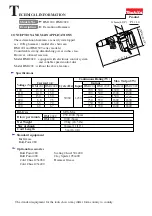
English |
21
Selecting drill chucks and tools
For hammer drilling and chiselling, you will need SDS plus
tools, which insert into the SDS plus drill chuck.
For drilling without impact in wood, metal, ceramic and
plastic as well as for screwdriving, tools without SDS plus
are used (e.g. cylindrical shank drill bits). For these tools,
you will need the keyless quick-change chuck
(1)
with integ-
rated impact stop.
Note:
Using the keyless quick-change chuck
(1)
with integ-
rated impact stop is the only way to ensure that the tools in-
serted are not damaged.
Changing the drill chuck
Removing the Quick-Change Chuck (see figure B)
– Pull back on the quick-change chuck locking ring
(6)
, hold
it in this position and pull the SDS plus quick-change
chuck
(2)
or the keyless quick-change chuck
(1)
out from
the front.
– Once the quick-change chuck is removed, protect it from
dirt.
Inserting the Quick-Change Chuck (see figure C)
– Before insertion, clean the quick-change chuck and lightly
grease the shank.
– Wrap your whole hand around the SDS plus quick-change
chuck
(2)
or the keyless quick-change chuck
(1)
. Use a
turning motion to push the quick-change chuck into the
drill chuck holder
(20)
until you hear it click into place.
– The quick-change chuck is automatically locked. Check
that it is locked by pulling on the quick-change chuck.
Changing the Tool
The dust protection cap
(4)
largely prevents the penetration
of drilling dust into the tool holder during operation. When
inserting the tool, make sure that the dust protection cap
(4)
does not become damaged.
u
Replace a damaged dust protection cap immediately.
It is recommended that you have use an after-sales
service for this.
Changing the tool (SDS plus)
Inserting SDS-plus application tools (see figure D)
The SDS-plus drill chuck enables you to change the applica-
tion tool easily and conveniently without needing to use ad-
ditional tools.
– Clean and lightly grease the insertion end of the applica-
tion tool.
– Insert the application tool into the tool holder while turn-
ing it until it locks automatically.
– Check the latching by pulling the tool.
As a requirement of the system, the SDS-plus application
tool can move freely. This causes a certain radial run-out at
no-load, which has no effect on the accuracy of the drill hole,
as the drill bit centres itself upon drilling.
Removing SDS-plus application tools (see figure E)
– Push the locking sleeve
(5)
back and remove the applica-
tion tool.
Changing the keyless quick-change chuck
Inserting the Application Tool (see figure F)
Note:
Application tools that do not have SDS plus must not
be used for hammer drilling or chiselling. Tools without SDS
plus and their drill chucks are damaged by hammer drilling
or chiselling.
– Insert the keyless quick-change chuck
(1)
with integrated
impact stop.
Note:
Only use the keyless quick-change chuck with integ-
rated impact stop specifically designed for the
GBH 18V-34 CF
. Using this drill chuck is the only way to en-
sure that the pneumatic impact mechanism of the rotary
hammer does not damage the application tools.
– Hold the retaining ring
(22)
of the keyless quick-change
chuck firmly in place. Open the tool holder by turning the
front sleeve
(21)
until the tool can be inserted. Hold the
retaining ring
(22)
in place and firmly tighten the front
sleeve
(21)
by turning it in the direction of the arrow until
you hear it click into place.
– Check that it is seated securely by pulling on the tool.
Note:
If the tool holder was unscrewed all the way, a scrap-
ing sound may be heard while retightening the tool holder
and it may not fully tighten.
In this case, turn the front sleeve
(21)
in the opposite direc-
tion to the arrow by one full turn. This will allow the tool
holder to be fully tightened.
– Turn the combi switch
(7)
to the "drilling" position.
Removing the application tool (see figure G)
– Hold the retaining ring
(22)
of the keyless quick-change
chuck firmly in place. Open the tool holder by turning the
front sleeve
(21)
in the direction of the arrow until the
tool can be removed.
Dust/Chip Extraction
The dust from materials such as lead paint, some types of
wood, minerals and metal can be harmful to human health.
Touching or breathing in this dust can trigger allergic reac-
tions and/or cause respiratory illnesses in the user or in
people in the near vicinity.
Certain dusts, such as oak or beech dust, are classified as
carcinogenic, especially in conjunction with wood treatment
additives (chromate, wood preservative). Materials contain-
ing asbestos may only be machined by specialists.
– Use a dust extraction system that is suitable for the ma-
terial wherever possible.
– Provide good ventilation at the workplace.
– It is advisable to wear a P2 filter class breathing mask.
The regulations on the material being machined that apply in
the country of use must be observed.
u
Avoid dust accumulation at the workplace.
Dust can
easily ignite.
Bosch Power Tools
1 609 92A 70J | (16.11.2021)
















































